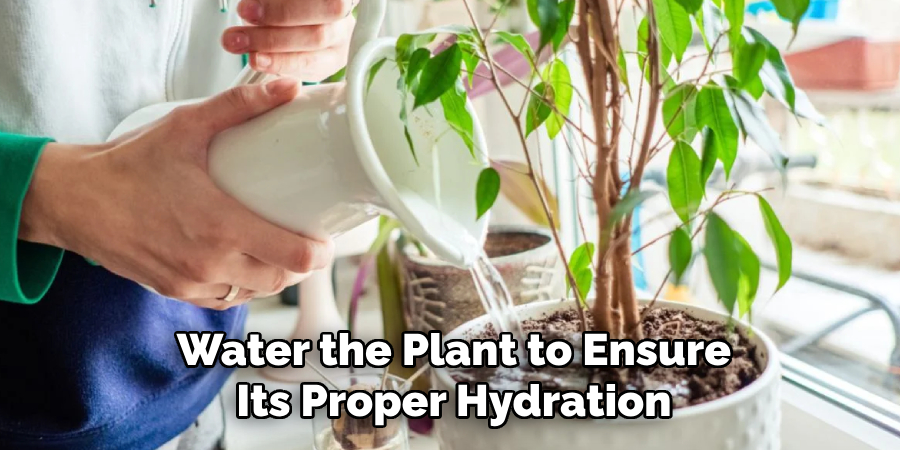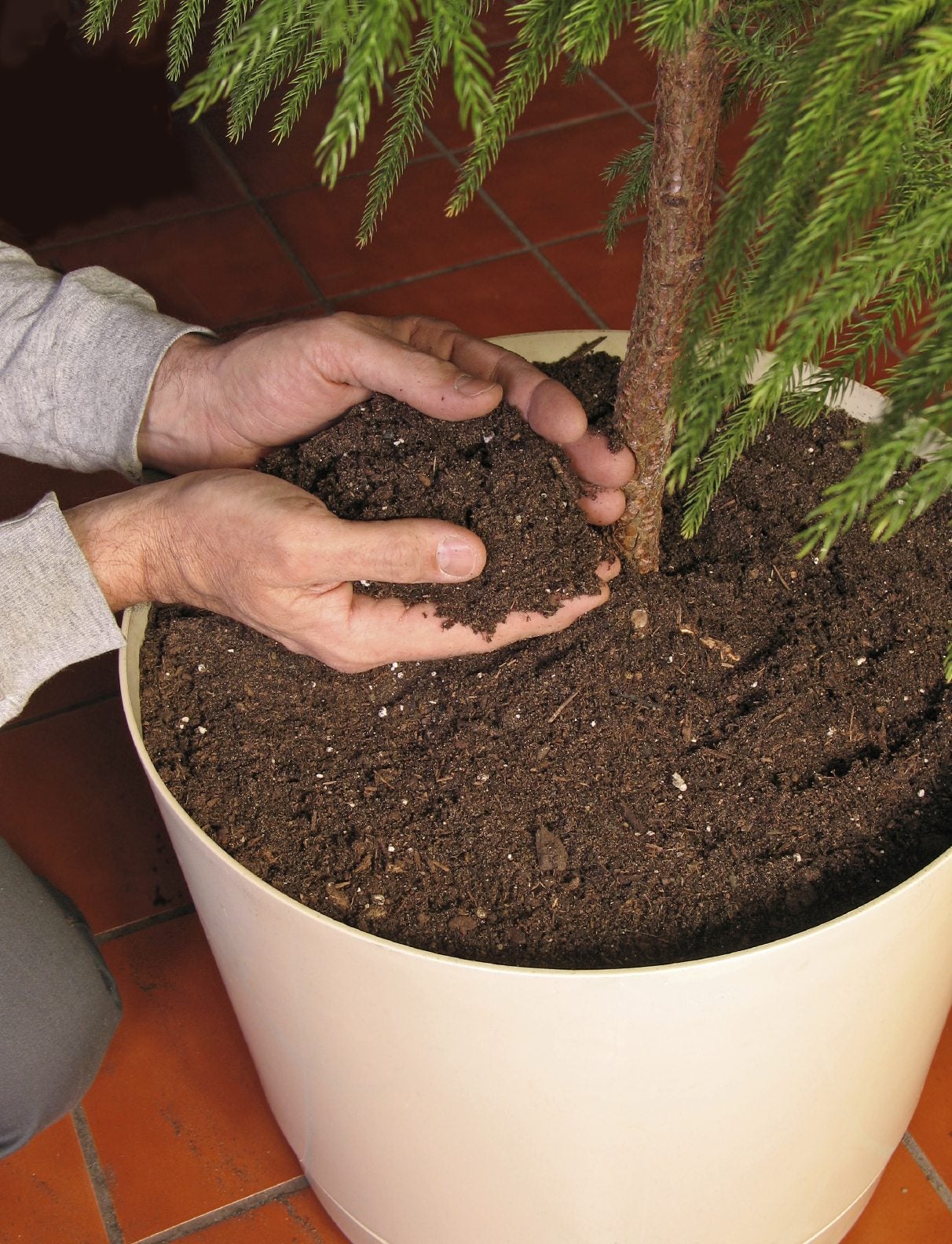To repot a large plant, gently remove it from its current container and place it in a new pot with fresh soil. Carefully support the roots and firm the soil around the base of the plant to ensure stability.
Repotting a large plant is an essential task for maintaining its health and growth. As plants grow, they may outgrow their containers, which can lead to root bound conditions and restricted growth. By repotting a large plant, you provide it with more space for root development, access to fresh nutrients in the soil, and improved drainage.
We will discuss the step-by-step process of repotting a large plant, including selecting the right container, preparing the soil, and properly transplanting the plant. By following these guidelines, you can ensure a smooth transition for your plant and promote its overall well-being.

Credit: www.joyusgarden.com
Gathering The Necessary Materials
To repot a large plant, the first step is to gather the necessary materials. Start by choosing a pot that is the right size for your plant. Make sure it has proper drainage holes. Next, purchase high-quality potting mix to provide nutrients and support for your plant.
You’ll also need to prepare a watering can or hose to ensure proper hydration. Once you have these materials ready, you can proceed with the repotting process. Remember to be gentle with the plant’s roots and to water it thoroughly after repotting.
By following these steps, you can successfully repot your large plant and promote its healthy growth.
How to Repot a Large Plant: Step by Step Guide
Preparing The Plant For Repotting
Preparing the plant for repotting requires removing it from its current pot. Loosen the root ball gently and trim any damaged or excess roots.
Repotting The Plant
Repotting a large plant is a simple process that requires only a few steps. First, place a layer of potting mix at the bottom of the new pot. Next, position the plant in the center of the new pot. Finally, fill the remaining space with potting mix, pressing lightly.
This will provide support and stability for the plant. Remember to choose a pot that is slightly larger than the current one to allow room for growth. By following these steps, you can ensure the health and vitality of your large plant.
Happy repotting!
Securing The Plant
To secure a larger plant, consider staking it if necessary. Attach the plant to a stake using soft ties or clips. This will provide additional support and prevent it from falling or bending. Staking is particularly important for plants with heavy foliage or weak stems.
By carefully securing the plant, you can ensure its stability and promote healthy growth. Remember to adjust the ties or clips as the plant grows to avoid constriction or damage. With proper staking, you can maintain the plant’s aesthetic appeal and prevent potential harm.
So, take the time to stake your larger plants and enjoy their beauty for years to come.
Watering And Finishing Touches
Repotting a large plant requires attention to watering and finishing touches. After repotting, make sure to thoroughly water the plant to ensure its proper hydration. Additionally, if the plant’s leaves are dirty, take the time to clean them gently for a fresh appearance.

Moreover, finding an appropriate location for the repotted plant is crucial. Consider factors such as sunlight, temperature, and space to provide the ideal environment for its growth. By following these guidelines, you can ensure a successful repotting experience for your large plant.
Tips For Successful Repotting
Repotting a large plant successfully requires certain tips to ensure the health of your plant. First, choose the right time for repotting, when the plant is in a dormant phase. This will minimize stress on the plant and optimize its chances of recovery.
Second, know the specific needs of your plant, such as the type of soil and pot size it requires. Understanding these requirements will make the repotting process more effective. Lastly, closely monitor the plant for any signs of stress or improvement after repotting.
This will help you make any necessary adjustments and ensure the plant adjusts well to its new pot. Following these guidelines will help you successfully repot your large plant and promote its overall well-being.
Frequently Asked Questions On How To Repot A Large Plant
How Often Should I Repot A Large Plant?
A large plant should be repotted every 1-2 years, depending on how quickly it outgrows its pot. Signs that it’s time to repot include roots poking out the drainage holes and soil drying out too quickly. Repotting provides fresh soil and space for the plant to grow.
What Size Pot Should I Use For Repotting A Large Plant?
When repotting a large plant, choose a pot that’s 1-2 inches larger in diameter than the current pot. This allows room for the plant’s roots to spread out and promotes healthy growth. Ensure the pot has drainage holes to prevent waterlogged soil and root rot.
How Do I Prepare The New Pot For Repotting A Large Plant?
Before repotting a large plant, prepare the new pot by cleaning it thoroughly with mild soap and warm water. Rinse well to remove any soap residue. Add a layer of fresh potting soil to the bottom of the pot, ensuring it’s evenly distributed and covers the drainage holes.
How Do I Gently Remove The Plant From Its Old Pot?
To remove a large plant from its old pot, gently tap the sides of the pot or squeeze it to loosen the root ball. Turn the pot upside down and support the plant with one hand. Lightly tap or squeeze the bottom of the pot until the plant slides out.
Be careful not to damage the roots.
How Should I Prepare The Root Ball Before Repotting A Large Plant?
Before repotting a large plant, gently loosen the root ball with your fingers or use a fork to tease apart the roots slightly. This encourages new root growth and prevents the roots from becoming root-bound. Be careful not to damage the roots while doing this.
How Do I Backfill The New Pot When Repotting A Large Plant?
When repotting a large plant, place it in the center of the new pot and hold it upright. Gradually fill the empty spaces around the root ball with fresh potting soil, gently pressing it down to eliminate air pockets. Leave a small gap between the soil surface and the pot rim for watering.
Conclusion
Repotting a large plant can be a challenging but rewarding endeavor. By following the steps outlined in this blog post, you can ensure your plant’s health and growth are optimized. Start by gathering all the necessary materials and selecting an appropriate pot.
Carefully remove the plant from its current pot, being cautious not to damage the roots. Trim any overgrown or damaged roots before placing the plant in its new pot, adding fresh soil to provide the necessary nutrients. Finally, water the plant thoroughly and place it in an appropriate location.
Remember to monitor the plant’s progress and make adjustments as needed. Proper repotting will not only promote the plant’s overall health and longevity but also enhance the aesthetics of your space. Enjoy the satisfaction of knowing you have successfully repotted your large plant, contributing to its vibrant future.

